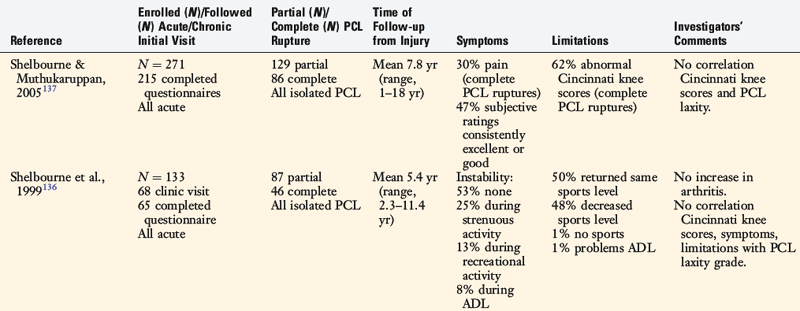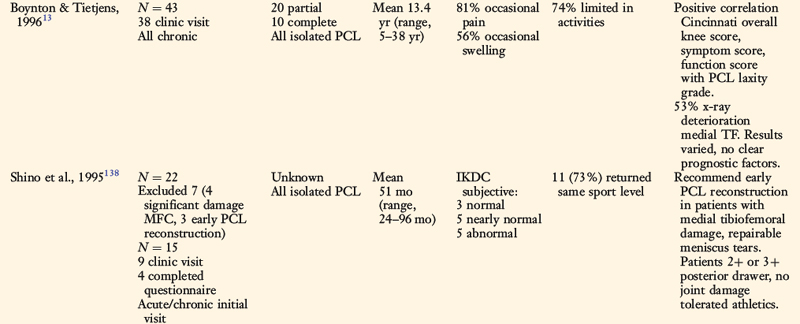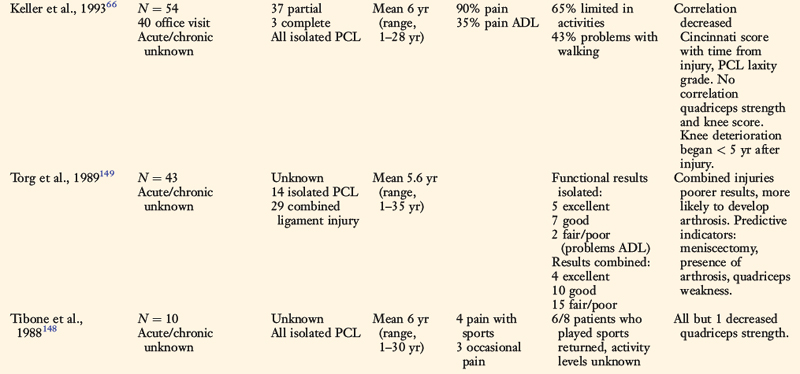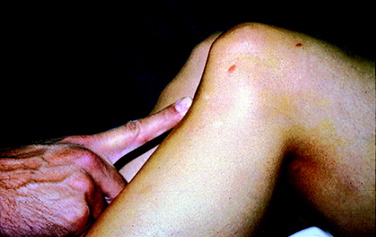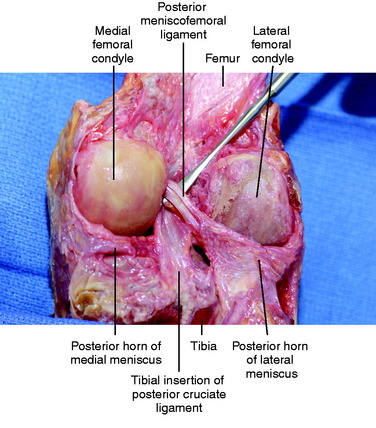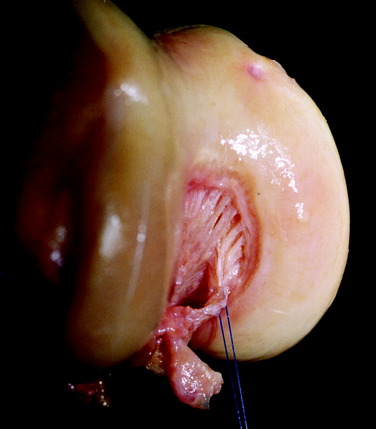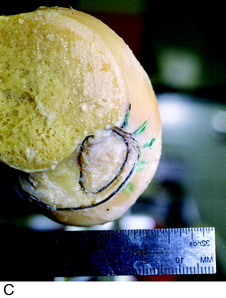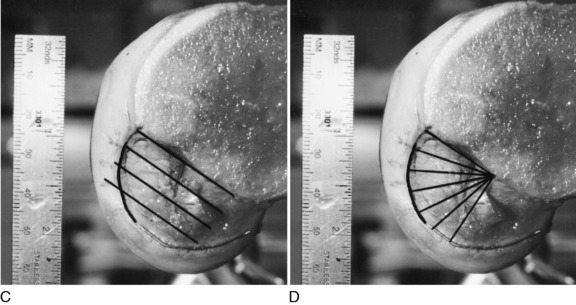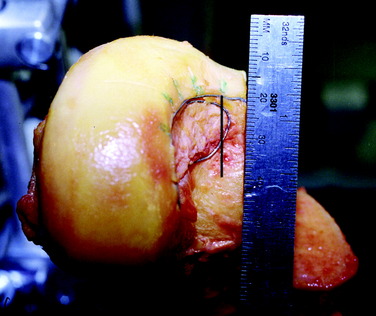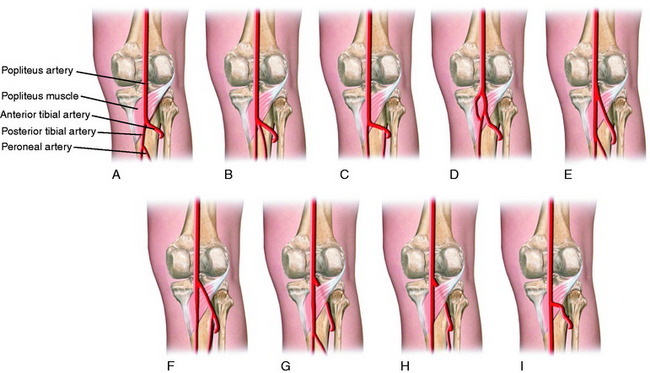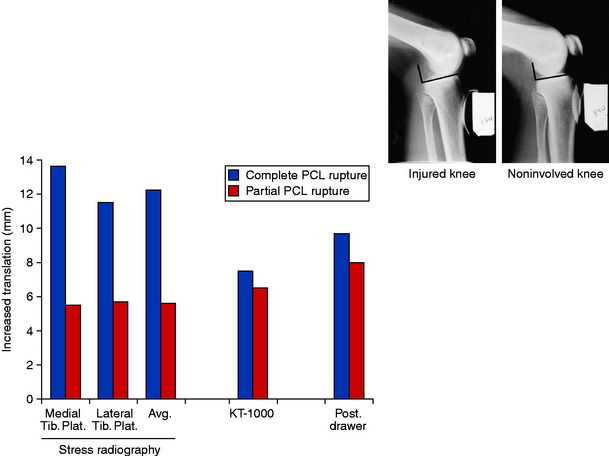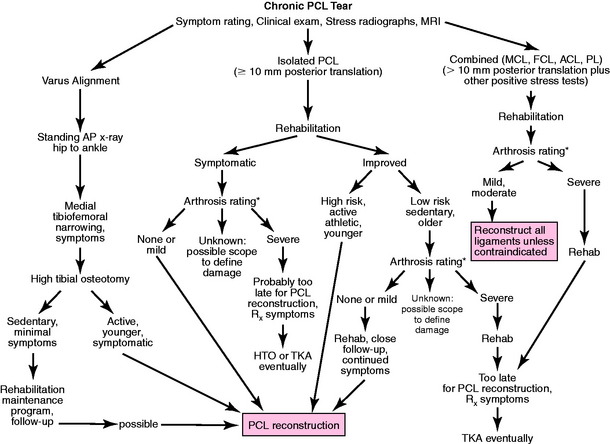Chapter 21 Posterior Cruciate Ligament
Diagnosis, Operative Techniques, and Clinical Outcomes
INDICATIONS
Complete ruptures to the posterior cruciate ligament (PCL) account for approximately 3% of all knee ligament injuries in the general population.160 However, in the trauma setting, the reported incidence of complete PCL ruptures has been as high as 37% of serious knee-related cases.40 These injuries are classified as either low-velocity in nature, such as those that occur from contact with another player in sports, or high-velocity, such as a dashboard injury in a motor vehicle accident.44 The mechanism of PCL rupture in athletes is usually a fall on the flexed knee with a plantar-flexed foot or hyperflexion of the knee.36 High-velocity injuries frequently involve dislocations with multiple ligament ruptures that require immediate medical attention. In this chapter, the different types of PCL reconstructive techniques are described in detail to allow the surgeon to select the procedure most suited for the specific knee injury. In addition, the initial diagnosis and management of acute PCL ruptures is addressed in the “Preoperative Planning” section.
The proper management of complete ruptures to the PCL requires thorough knowledge of anatomy, diagnosis, surgical reconstruction, and rehabilitation concepts. Some aspects of the treatment of complete isolated PCL ruptures are controversial owing to the unknown natural history in regard to long-term symptoms, functional limitations, and risk of joint arthritis. Whereas some studies (that included patients with partial PCL deficiency) report that patients do well when treated conservatively,29,44,116,136–138,148,149 other investigations describe noteworthy symptoms and functional limitations years after the injury that can be disabling13,30,34,66 (Table 21-1). A high percentage of knees with complete PCL ruptures develop articular cartilage deterioration over time that usually occurs on the medial femoral condyle and patellofemoral surfaces owing to increased joint pressures.13,49,50,147 Posterior tibial subluxation after PCL rupture has a deleterious effect to the knee similar to that of a medial meniscectomy, because there is loss of medial meniscus function and increased joint contact stress. There is less of an effect to the lateral meniscus, which retains load-bearing function. Posterior tibial subluxation results in a loss of normal joint kinematics and in coupled external tibial rotation with joint loading. Accordingly, a PCL rupture would be expected to have a more deleterious effect in a varus-angulated knee with associated loss of the medial meniscus and, in particular, larger athletes desiring a return to strenuous athletics. All of these factors alone or together result in substantial medial tibiofemoral loads and risk of joint deterioration.
The indications for surgical reconstruction in knees with a chronic isolated complete PCL rupture are pain and instability with athletics or other activities, swelling, and 10 mm or more of increased posterior tibial translation at 90° flexion (Fig. 21-1). PCL reconstruction is most frequently performed in dislocated knees with gross instability due to other ligament injuries to the anterior cruciate ligament (ACL), medial collateral ligament (MCL; see Chapter 24, Medial and Posteromedial Ligament Injuries: Diagnosis, Operative Techniques, and Clinical Outcomes), or posterolateral structures (see Chapter 22, Posterolateral Ligament Injuries: Diagnosis, Operative Techniques, and Clinical Outcomes). Indications for surgery in acute isolated PCL ruptures are discussed later in this chapter.
If symptomatic meniscal tears or early patellofemoral or tibiofemoral articular cartilage damage is present, early PCL reconstruction is recommended with the goal of decreasing joint deterioration over time. The results of PCL reconstruction in knees with chronic ruptures are not as favorable as those that undergo reconstruction for acute injuries. This is because patients present with pain and swelling due to joint deterioration that often persists even though some benefit may be gained from improved knee stability obtained from the operative procedure.95
CONTRAINDICATIONS
In addition, patients with chronic PCL deficiency who have severe muscle atrophy, loss of knee motion, or hyperextension gait abnormalities require extensive rehabilitation and gait retraining (see Chapter 34, Correction of Hyperextension Gait Abnormalities: Preoperative and Postoperative Techniques) before reconstruction.107
PCL ANATOMY
The PCL arises from a depression posterior to the intra-articular upper surface of the tibia and courses anteromedially behind the ACL to the lateral surface of the medial femoral condyle and is described in detail in Chapter 2, Lateral, Posterior, and Cruciate Knee Anatomy (Fig. 21-2). The PCL has an average length of 38 mm and an average width of 13 mm.51,155 The cross-sectional area of the PCL is variable and increases from tibial to femoral insertions.58 It is approximately 50% larger than the ACL at its femoral origin and 20% larger than the ACL at its tibial insertion.
Critical Points CONTRAINDICATIONS
Critical Points POSTERIOR CRUCIATE LIGAMENT ANATOMY
ACL, anterior cruciate ligament; PCL, posterior cruciate ligament.
Free nerve endings and mechanoreceptors have been identified in the femoral and tibial attachment sites and on the surface of the PCL.65,131 The mechanoreceptors resemble Golgi tendon organs and are believed to have a proprioceptive function in the knee.67
In a histologic study of the PCL in cadaveric knees, Katonis and coworkers65 reported a neural innervation similar to that of the ACL. Specifically, the PCL contains type I or Ruffini’s corpuscles, which have a slow threshold to pressure changes; type II (Vater-Pacini corpuscles), which are more rapid acting, and type IV (free nerve endings) for pain reception. The mechanoreceptors are located at each ligament bony attachment and on the surface of the PCL.
The meniscofemoral ligaments are in close proximity to the PCL. They arise from the posterior horn of the lateral meniscus and insert near the PCL insertion site on the lateral aspect of the medial femoral condyle.58 The anterior meniscofemoral ligament (ligament of Humphry) courses anterior to the PCL, and the posterior meniscofemoral ligament (ligament of Wrisberg) runs obliquely behind the PCL. Frequently, the anterior meniscofemoral ligament interdigitates with the PCL fiber attachments on the medial femoral condyle (Fig. 21-3).87 At least one of the meniscofemoral ligaments is present in 91% of knees, and both ligaments may be found in 50% of knees in young individuals.55,58,87 The biomechanical function of the meniscofemoral ligaments is discussed in detail in Chapter 28, Meniscus Tears: Diagnosis, Repair Techniques, and Clinical Outcomes.
The traditional division of the PCL into separate anterolateral and posteromedial bundles oversimplifies PCL fiber function. The PCL is a complex anatomic structure composed of a continuum of fibers of different lengths and attachment characteristics. The length-tension behaviors of the fibers that resist posterior tibial translation (with knee flexion) are controlled primarily by femoral attachment regions.28,46,54,76,77,129,135,140 The distal fibers lengthen with increasing knee flexion and the proximal fibers shorten with knee flexion.87,129 A detailed description of the length-tension behavior of the PCL appears in Chapter 20, Function of the Posterior Cruciate Ligament and Posterolateral Ligament Structures.
The anatomy of the PCL femoral attachment site has been studied extensively.87,129 Variation exists between knees in the shape of this attachment, from the common elliptical shape to a more rounded and thicker shape (Fig. 21-4).87 Differing measurement systems have been proposed to describe the femoral attachment site. The most accurate of these methods uses a clock reference position (Fig. 21-5), with measurement lines perpendicular to the articular cartilage edge and measurement lines parallel to the femoral shaft (Fig. 21-6).
In general, the PCL attachment extends from high in the notch (11:30 to 5 o’clock position on a right knee) along the medial femoral condyle notch. The anterior portion of the PCL attachment follows the articular cartilage within 2 to 3 mm of its edge and gradually recedes deeper with the notch until, at the 5 o’clock position, the posterior third is 5 mm from the articular margin. Therefore, the distal boundary of the PCL femoral attachment does not parallel the articular margin as reported by others51,154 but is farthest away from the cartilage margin posteriorly.
The distance of the distal edge of the attachment to the articular cartilage margin is 3.2 ± 0.8 mm at the roof, 5.8 ± 2.2 mm at its midportion, and 7.9 ± 2.2 mm at its “lowest” extent.129 The distal and proximal measurements for the PCL femoral attachment are shown in Table 21-2. The proximal edge of the PCL is usually straight or partially oval, with the attachment tapered in width along its posterior portion.
TABLE 21-2 PCL Femoral Attachment Measurements Made with the Femoral Condyle Articular Cartilage Clock System
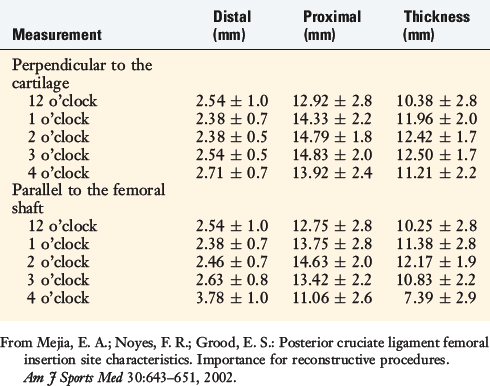
The PCL attachment measurements parallel to the intercondylar roof are shown in Table 21-3. The length of the radial measurement lines extending from the intercondylar roof is shown in Table 21-4. This method provides a means to measure the middle and lower portions of the PCL and provides information on the distance from the lowest cartilage margin to the most posterior portion of the PCL attachment.
The use of measurement lines perpendicular to the cartilage edge is preferred for describing the distal attachments of the PCL (see Fig. 21-6A). The disadvantage of this system is that the 12 o’clock and usually the 1 o’clock measurements cannot be made parallel to the femoral shaft, but must be made perpendicular to the cartilage (Fig. 21-7).
A clear understanding of the anatomy of the native PCL is critical to determining what portion of the ligament will be reconstructed. The terms “high,” “low,” “shallow,” and “deep” are only general descriptors. Because there may be considerable confusion regarding femoral graft tunnel placement during PCL reconstruction, the PCL femoral attachment is described using the rule of thirds (Fig. 21-8A and B) to define the proximal-middle-distal thirds (deep to shallow in the femoral notch) and anterior-middle-posterior thirds (high to low), with a small posterior oblique portion in the sagittal plane.87,91 This provides a grid for the identification of the tunnel locations for the graft strands and is preferred over the historical division of an anterolateral or a posteromedial bundle (see Fig. 21-8C).
It is well appreciated the PCL graft femoral attachment location strongly influences graft tension and the ability of the reconstruction to restore posterior stability.5,47,129,135 Investigations by Grood and associates53 and Sidles and colleagues140 demonstrate that the femoral attachment location determines the graft tibiofemoral separation distance with knee flexion-extension, much more so than the tibial attachment location. The proximal-distal femoral location of a graft has a greater effect on the attachment separation distance than the anteriorposterior (AP) femoral location, which is the basis for the rule of thirds (see Fig. 21-8B). A graft placed in the distal and middle thirds elongates with knee flexion, whereas a graft placed in the proximal third elongates with knee extension. These concepts are used to select PCL graft attachment locations and tensioning described in the “Operative Techniques” section.
VASCULAR ANATOMY AND VARIATIONS
The vascular supply to the cruciate ligaments is provided mostly by the middle genicular artery, which is a branch of the popliteal artery that penetrates the posterior capsule of the knee.4,130 The PCL is covered with a well-vascularized synovial sleeve that contributes to its blood supply. The distal portion of the PCL also receives some vascular supply from capsular vessels originating from the inferior genicular arteries and the popliteal artery.
Detailed knowledge of posteromedial knee anatomy, especially the vascular structures, is required to avoid complications when using a posteromedial approach to a tibial inlay PCL reconstruction (see Chapter 2, Lateral, Posterior, and Cruciate Knee Anatomy). The popliteal artery originates at the adductor hiatus and passes through the popliteal fossa. Before passing deep to the fibrous arch over the soleus muscle, it divides into the anterior and posterior tibial arteries at the distal aspect of the popliteus muscle.
Critical Points VASCULAR ANATOMY AND VARIATIONS
This “normal” vascular pattern has been reported to occur in approximately 88% of cases.31,84 In approximately 5% to 7% of cases, the popliteal artery will divide at least an inch or more proximal to the distal border of the popliteus muscle.26,31,84 In slightly less than half of these cases, with a high division of the popliteal artery, the anterior tibial artery passes anterior, not posterior, to the popliteus muscle belly.153 The number of variations of the anterior tibial artery according to Mauro and coworkers84 is illustrated in Figure 21-9. Therefore, with a tibial inlay approach, the dissection is always proximal to the popliteus muscle with a meticulous technique, because the anterior tibial artery is at risk for transection in approximately 3% to 4% of knees.
An unusual variation in the vascular pattern involves the popliteal artery passing medial and then beneath the medial head of the gastrocnemius. Various subtypes of this abnormal pattern have been described. An abnormal vascular pattern may manifest clinically as the popliteal artery entrapment syndrome, which is characterized by vascular claudication symptoms.70,125,143 Arterial insufficiency occurs most commonly with entrapment of the artery deep to the medial gastrocnemius muscle, but can also occur when the artery is entrapped deep to the popliteus muscle (persistence of ventral component of artery) or deep to an abnormal accessory head of the gastrocnemius. A history of pain in the lower extremity with activity and disappearance with rest, particularly in a young patient, should alert the surgeon to the possibility that an abnormal vascular pattern may exist. Further evaluation with magnetic resonance imaging (MRI) or angiography may be warranted.45,74
The anterior tibial artery arises as a branch of the popliteal artery and initially courses anterior to the popliteus muscle. In humans, the early anterior tibial artery is replaced with the superficial popliteal artery and passes posterior to the popliteus muscle, which then gives rise to the anterior tibial artery. Furthermore, during embryonic life, the medial head of the gastrocnemius migrates medially and cranially. It is with this migration that the popliteal artery can be caught and swept medially with the muscle.84,125
CLINICAL EVALUATION
Physical Examination
A comprehensive examination of the knee joint is required to detect all abnormalities. This includes assessment of (1) the patellofemoral joint and extensor mechanism malalignment, which may occur if increased external tibial rotation exists owing to posterolateral ligament injury that accompanies the PCL rupture; (2) patellofemoral and tibiofemoral crepitus, indicative of articular cartilage damage; (3) gait abnormalities (excessive hyperextension or varus thrust) during walking and jogging107; and (4) abnormal knee motion limits and subluxations compared with those of the contralateral knee.109
Experienced clinicians are aware that patients with chronic deficiency of the PCL and posterolateral structures may develop an abnormal gait pattern characterized by excessive knee hyperextension during the stance phase.107 Subjective complaints of knee instability and giving-way during routine daily activities, along with severe quadriceps atrophy, often accompany this gait abnormality. Gait analysis and retraining are required in patients who demonstrate abnormal knee hyperextension patterns before proceeding with any ligament reconstruction (see Chapter 34, Correction of Hyperextension Gait Abnormalities: Preoperative and Postoperative Techniques).107 The failure to do so may lead to failure of reconstructed ligaments if the abnormal gait pattern is resumed postoperatively.
Diagnostic Clinical Tests
The medial posterior tibiofemoral step-off on the posterior drawer test is performed at 90° of flexion. The amount of posterior tibial translation will vary between knees with isolated PCL ruptures due to physiologic laxity or injury to the secondary posterolateral or medial soft tissue restraints. Posterior tibial translation progressively increases with injury to the secondary restraints. The importance of determining abnormal medial or lateral joint opening and increases in external-internal tibial rotation cannot be overemphasized, because the failure to correct these associated subluxations places PCL graft reconstructions under high in vivo forces postoperatively and risk of graft failure. The diagnostic tests and their interpretation are discussed in Chapter 20, Function of the Posterior Cruciate Ligament and Posterolateral Ligament Structures, and are shown in Table 22-1.
The exact determination of the extent of a PCL tear (partial vs. complete) can be difficult, but is essential from a therapeutic standpoint. The clinical posterior drawer test can be highly subjective, with the forces applied too variable to allow accurate determination of the status of the PCL. MRI is not always accurate in diagnosing partial PCL tears (Fig. 21-10). Frequently, this test may indicate that the ligament is completely ruptured; however, ligament continuity may still exist with some portions functioning to limit posterior tibial subluxation to only a few millimeters. Patten and associates117 reported only a 67% sensitivity rate of the ability of MRI to distinguish complete from partial PCL tears by identifying focal areas of ligamentous discontinuity.
The quantitative measurement of posterior tibial subluxation in knees with PCL ruptures or reconstruction is therefore important.60 The knee arthrometer is the most frequently used device to measure posterior tibial translation after PCL injury and reconstruction. However, the knee arthrometer underestimates the true amount of posterior translation in PCL-deficient and reconstructed knees, often by several millimeters.60,78,146 Stress radiography is the most accurate and reproducible technique currently available,37,43,60,78,119,132 yet only a few studies to date have used this method to document posterior tibial translation after PCL reconstruction. The authors recommend that PCL clinical investigations incorporate stress radiography to provide a more valid measure of posterior tibial translation (Fig. 21-11). To correct for tibal rotation, which can produce errors in measurement, the radiograph should be as close to a pure lateral as possible, with the two femoral condyles superimposed upon themselves. A horizontal line is placed across the medial tibal plateau and a perpendicular line determines the posterior position of each femoral condyle. A similar measurement is made for the most posterior position of the medial and lateral tibial plateau. The amount of tibial translation is the average of both of these measurements.
The tibiofemoral rotation dial test at 30° and 90° is done to determine whether increases in external tibial rotation exist with posterior subluxation of the lateral tibial plateau (see Fig. 22-3).109 This test is described in further detail in Table 22-1.
Radiographic Assessment
Posterior stress radiographs are done with an 89-N force applied to the proximal tibia.60 A lateral radiograph is taken of each knee at 90° of flexion. The limb is placed in neutral rotation with the tibia unconstrained and the quadriceps relaxed. The difference in posterior tibial displacement between the reconstructed knee and the contralateral knee is recorded. More than 8 mm of increase in posterior tibial translation on stress testing indicates a complete PCL rupture.132
Full standing radiographs of both lower extremities, from the femoral heads to the ankle joints, are done in knees in which varus lower extremity alignment is detected on clinical examination. The mechanical axis and weight-bearing line are measured to determine whether HTO is indicated before PCL reconstruction (see Chapter 31, Primary, Double, and Triple Varus Knee Syndromes: Diagnosis, Osteotomy Techniques, and Clinical Outcomes).35,105 If the varus malalignment is not corrected, there is a risk that either a PCL or an ACL graft may fail owing to the varus thrusting forces and concurrent increased lateral joint opening producing high graft tension loads.96
Patients complete questionnaires and are interviewed for the assessment of symptoms, functional limitations, sports and occupational activity levels, and patient perception of the overall knee condition according to the Cincinnati Knee Rating System (CKRS).6
PREOPERATIVE PLANNING
Acute Ruptures of the PCL
Controversy exists in the treatment of midsubstance complete PCL ruptures, primarily owing to the lack of a scientifically-proven operative procedure that can predictably restore posterior stability and PCL function. In comparison, surgical procedures to reattach the native PCL in cases of bony avulsion injuries or peel-off injuries directly at the PCL attachment site have more predictable healing rates.12,73,151,152 Even in cases of PCL rupture directly at the attachment site, usually sufficient ligament substance remains for a direct repair. In select situations, an augmentation using the semitendinosus tendon may facilitate PCL repair.
Augmentation of partial PCL tears is controversial.3,63,156 Graft reconstruction of the so-called posteromedial portion of the PCL has been described in which the “anterolateral bundle” is still intact and functional. The authors have no experience with this technique and have not performed augmentation procedures in the acute setting. Stress radiography plays an important role in determining whether an abnormal increase of 10 mm or more exists, indicating loss of PCL function. Partial ligament tears are treated conservatively with an extension brace and posterior calf pad to allow for potential PCL healing.
Critical Points PREOPERATIVE PLANNING
Acute Ruptures
 2 wk: 0°–90° of motion maintaining anterior tibial translation load. Patient sleeps in brace, no unsupervised knee motion.
2 wk: 0°–90° of motion maintaining anterior tibial translation load. Patient sleeps in brace, no unsupervised knee motion. 4 wk: active quadriceps extension out of brace, 50% weight-bearing, crutch support, maintain brace protection.
4 wk: active quadriceps extension out of brace, 50% weight-bearing, crutch support, maintain brace protection. 5–6 wk: wean from the brace and crutch support, rehabilitation (see Chapter 23, Rehabilitation of Posterior Cruciate Ligament and Posterolateral Reconstructive Procedures).
5–6 wk: wean from the brace and crutch support, rehabilitation (see Chapter 23, Rehabilitation of Posterior Cruciate Ligament and Posterolateral Reconstructive Procedures).Chronic Injuries
MRI, magnetic resonance imaging; PCL, posterior cruciate ligament.
The treatment rationale for patients with acute PCL ruptures is shown in Figure 21-12. The algorithm is divided into three major sections based on the PCL tear (partial, complete, or combined with other ligament ruptures). The 10-mm division is somewhat arbitrary. As discussed, stress radiography is helpful in determining the exact increase in posterior tibial translation. The rules to treat partial or acute isolated PCL tears are
In the authors’ experience, 4 weeks of protection to allow initial healing of a complete PCL rupture will frequently restore partial PCL function, with less than 10 mm residual posterior tibial subluxation. The initial PCL healing process involves a low tensile strength and an additional 4 to 6 weeks of protection is recommended, including avoiding athletics, running, walking on downhill grades, walking down stairs, or other high knee flexion activities that load the PCL. Even in knees with a complete PCL tear and more than 10 mm of increased posterior tibial displacement, healing of the disrupted PCL fibers may still occur, although a residual posterior tibial subluxation of a few millimeters (with a hard endpoint) will remain. These knees in which partial PCL function has been restored should be followed and repeat stress radiographs obtained at 6 months and over the next few years to determine PCL function. These partial PCL tears seldom require reconstruction. However, Shelbourne and associates136,137 described that one third or more of patients in this group have abnormal knee scores and pain with athletic activities owing usually to concomitant articular cartilage damage. A repeat MRI with fast-spin-echo cartilage sequences122 helps determine the integrity of the articular cartilage and provides important information for counseling the patient on athletic activities to decrease the risk of future joint arthritis.
In cases of complete isolated midsubstance PCL ruptures that have more than 10 mm of increased posterior tibial displacement in which the patient is seen late after the injury and the previously discussed program cannot be instituted, one treatment approach in athletes and those in strenuous high-risk occupations is PCL graft reconstruction before the secondary restraints stretch out with subsequent reinjury. The authors believe that, in athletic individuals, PCL reconstructive procedures have advanced to the point at which more predictable results can be expected to restore sufficient PCL function to prevent gross posterior tibial subluxation. Studies have demonstrated, at least in the short term, that the majority of patients with acute PCL ruptures treated with reconstruction are able to return to various levels of sports activities.95 Additional factors to be weighed in the decision to perform early surgery on an isolated PCL rupture (with > 10 mm posterior displacement, 90° flexion) include athletic goals, body weight, medial meniscus or tibiofemoral joint damage, patellofemoral joint damage, and varus malalignment; these factors add to the effects of the residual posterior subluxation in increasing knee joint loads and subsequent joint deterioration. Future long-term clinical studies will confirm the importance of these factors in the operative decision of early restoration of PCL function in active younger individuals who subject their knee to high forces in sports or work activities. Sedentary patients with a complete PCL rupture and more than 10 mm of posterior translation (90° flexion) are not considered surgical candidates; however, they are followed as previously described.
Patients with a PCL disruption and other ligament injuries have an obvious posterior tibial dropback without a firm endpoint on posterior drawer testing, and 10 mm or more of posterior tibial subluxation. In almost all of these knees, some increase in medial or lateral joint opening or external tibial rotation can be detected, although the findings may be subtle. There may be physiologic laxity of other ligament structures without a true injury (see Chapter 3, The Scientific Basis for Examination and Classification of Knee Ligament Injuries) that allows for the gross posterior tibial subluxation.
In knees that present with acute disruption of the PCL and medial or posterolateral structures, reconstruction should be delayed until the neurovascular status and other injuries are resolved and major knee ligament surgery can be safely performed. In knees that have associated posterolateral ruptures, acute anatomic repair is required within 14 days before scarring occurs and the ability to anatomically restore these structures is lost (see Chapter 22, Posterolateral Ligament Injuries: Diagnosis, Operative Techniques, and Clinical Outcomes). A similar situation exists for the medial ligament structures; however, these tissues are easier to reconstruct later if surgery cannot be performed in the ideal time period for anatomic repair. There may exist a displaced meniscus tear requiring early treatment. As a word of caution, a displaced meniscus should be reduced into the tibiofemoral joint by 3 weeks to prevent meniscus shortening and scarring that compromises a future repair and results in loss of meniscus function. Even in knees that have marked soft tissue swelling and edema, and in which major ligament reconstruction is contraindicated, a meniscus repair procedure using all-inside techniques can be performed to reduce the meniscus to a normal tibiofemoral position. The mistake is to wait until 6 weeks or later, expecting that the meniscus repair can be performed at that time.
Too frequently, major ligament surgery in dislocated knees performed under acute conditions results in joint arthrofibrosis, compromising the result. Patients should be carefully selected for acute multiligament repairs, realizing that there are proven techniques for reconstruction of the ruptured ligaments performed later under more ideal conditions. When surgery is performed on acute combined PCL and posterolateral ruptures, the procedure includes the use of appropriate grafts to restore lateral stability and allow an early protected range of knee motion program, described in Chapter 22, Posterolateral Ligament Injuries: Diagnosis, Operative Techniques, and Clinical Outcomes. The majority of acute knee dislocations should be treated in a staged approach by first treating the acute injury and then determining whether a ligament reconstruction should be performed either within the 10- to 14-day envelope or delayed. When early surgery is not advisable, the knee is protected for the first 4 weeks to prevent posterior tibial subluxation, as already described for acute isolated PCL ruptures. A lateral radiograph is obtained with the knee placed in a posterior plaster shell and a soft bolster positioned beneath the calf to prevent posterior tibial subluxation. The capsular tissues heal in 7 to 10 days to provide enough stability to prevent recurrence of dislocation.
If a nonoperative approach is selected with associated MCL and posteromedial capsular disruptions, the same program is followed with the lower limb placed in a cylinder cast to allow “stick-down” of the medial soft tissues. Plaster immobilization is required because a soft hinged brace, even if maintained at 0° of extension, does not provide sufficient protection to maintain medial joint line closure to allow the disrupted medial tissues to heal. At 7 to 10 days, the cylinder cast is split into an anterior and a posterior shell and the therapist assists the patient with range of motion from 0 to 90° in a figure-four position with the hip joint externally rotated to protect the healing medial tissues. This program of “aggressive” nonoperative treatment of associated medial ligament injuries is described in further detail in Chapter 25, Rehabilitation of Medial Ligament Injuries.
Chronic Ruptures of the PCL
The algorithm for the treatment of chronic PCL ruptures is shown in Figure 21-13. The symptoms and clinical examination determine the functional limitations, particularly the component of symptoms due to medial tibiofemoral or patellofemoral arthritis because these problems are likely to persist after surgical stabilization. Knees with chronic PCL ruptures are arbitrarily divided into three categories; those with varus osseous malalignment (and, rarely, valgus malalignment) in which an osteotomy must be considered, those with an isolated PCL rupture in which reconstruction may or may not be necessary, and those with significant combined ligament injuries that require reconstruction.
If a nonoperative approach is elected, the clinician should warn the patient that the return to athletic activities may carry an uncertain prognosis, and that although sports may be resumed in the short term, some form of joint arthritis will eventually ensue. It is therefore important to follow the patient at regular intervals. A bone scan may be used to provide some indication of abnormal blood flow dynamics; however, it is the authors’ experience that the onset of pain and swelling usually indicates more advanced joint damage and a poor prognosis after PCL reconstruction. An MRI with fast-spin-echo sequences122 provides a baseline for repeated studies at 1- to 2-year intervals. The nonoperative treatment protocol of chronic PCL injuries involves educating the patient to avoid activities such as lunges and other high knee flexion activities that increase posterior tibial subluxation.
INTRAOPERATIVE EVALUATION
Critical Points INTRAOPERATIVE EVALUATION
All knee ligament subluxation tests are performed after the induction of anesthesia in both the injured and the contralateral limbs. The amount of increased anterior tibial translation, posterior tibial translation, lateral joint opening, medial joint opening, and external tibial rotation is documented. In acute knee injuries, arthroscopic pressure is maintained at a low setting with adequate outflow at all times to prevent fluid extravasation. A thorough arthroscopic examination should be conducted, documenting articular cartilage surface abnormalities112 and the condition of the menisci.
The medial and lateral tibiofemoral gap test is done during the arthroscopic examination (see Fig. 22–2).103 The knee is flexed 30° and a varus and valgus load of approximately 89 N is applied. A calibrated nerve hook is used to measure the amount of lateral and medial tibiofemoral compartment opening. Twelve millimeters or more of joint opening at the periphery of the compartment indicates the need for a combined lateral or medial ligament reconstructive procedure to protect and unload the PCL reconstruction. The goal is to restore the function of all ligament structures to normal or nearly normal and not leave a knee with a residual ligament insufficiency. This also applies to the ACL, which is reconstructed at the time of PCL surgery, if deficient.
OPERATIVE TECHNIQUES
PCL operative techniques continue to evolve, and clinical outcome studies remain limited to allow precise decision making. This chapter describes the senior author’s recommended surgical approach and relative advantages and disadvantages of each procedure, realizing that this is an evolving treatment approach (Table 21-5).
TABLE 21-5 Recommended Surgical Approaches
| All-Inside |
| Single-Tunnel Tibial Approach |
| Two-Tunnel Femoral Approach |
| Tibial Inlay |
| Graft Selection |
| Isolated PCL Rupture |
| PCL Combined Other Ligament Rupture |
Critical Points AUTHORS’ PREFERRED OPERATIVE TECHNIQUES
< div class='tao-gold-member'>
Stay updated, free articles. Join our Telegram channel

Full access? Get Clinical Tree


